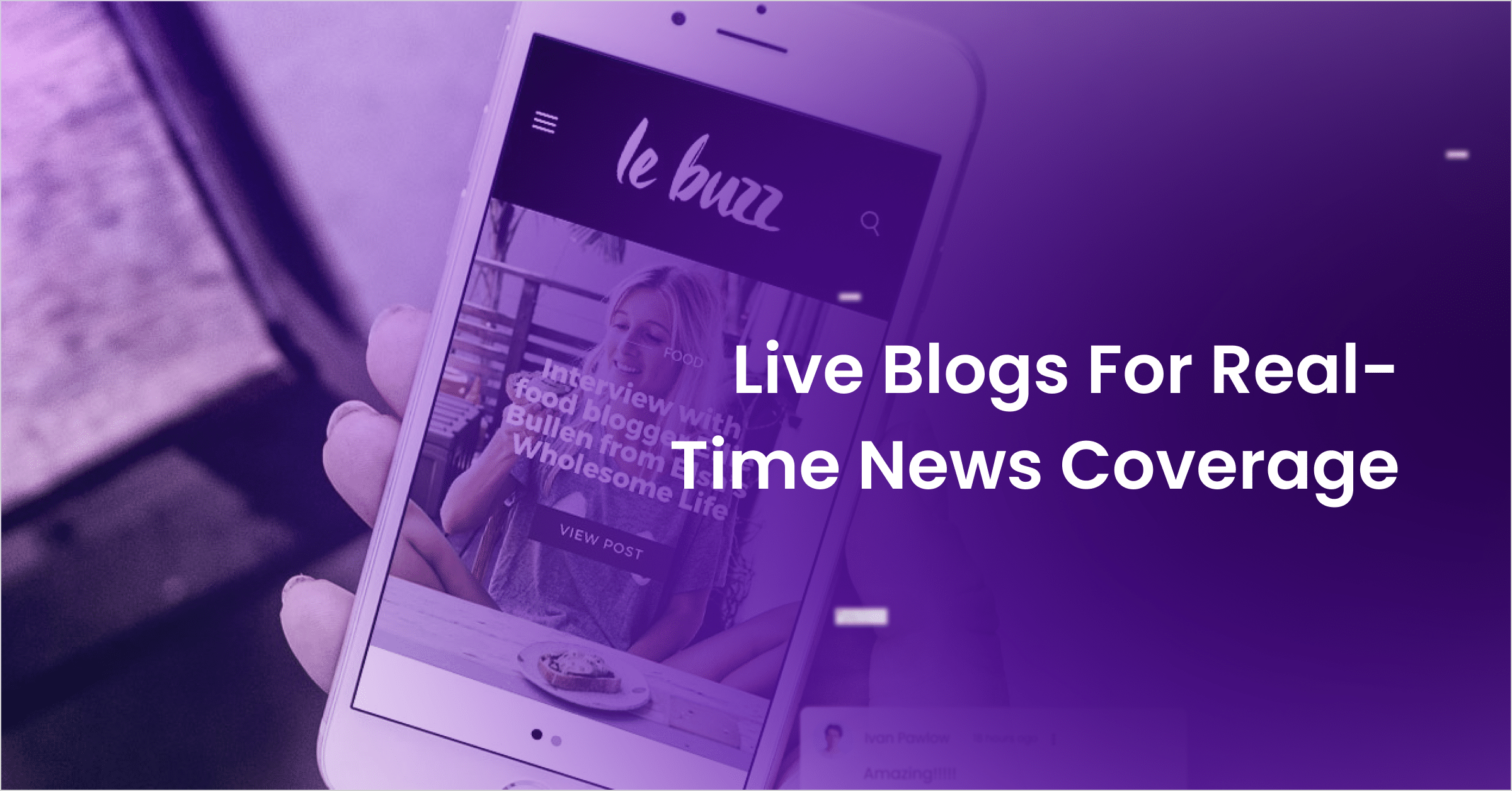Media and publisher brands build trust with live blogging, seeking new methods to establish credibility with their audiences. Live blogging offers transparency and immediacy through real-time interactions that engage online readers.
With this guide to live blogging, these brands can enhance audience engagement and establish themselves as trusted sources by incorporating live blogging into their content.
Why Live Blogging for Media Brands Helps Build Trust
1. Engage Directly with the Audience
Directly engaging with your audience builds trust and fosters a loyal community, which can help create a loyal readership with community tools.
Live blogging offers various methods to enhance interaction and involve readers in storytelling, especially when utilizing live blogs for event coverage, thus enhancing reader engagement.
- You can enable real-time comments and discussions to create a sense of immediacy and community. Adding Q&A sessions with reporters or experts and incorporating polls and surveys invites audience participation and provides valuable feedback. For example, during a live blog of a sports event, inviting fans to share predictions or opinions creates an engaging atmosphere. Implementing the best live sports streaming practices can enhance audience participation.
- Incorporating user-generated content, such as eyewitness reports or photos, enhances the authenticity and relatability of your live blog. This enriches your content and empowers your audience to contribute to the narrative.
- Using group chat tools adds another layer of engagement, enabling real-time viewer engagement. Group chats allow for real-time community interactions, helping you to gather first-party data (see our first-party data strategies), understand your audience’s preferences, and tailor the experience to individual needs.
2. Show Expertise and Authority
Demonstrating expertise and authority through live blogging builds trust and enhances your brand’s credibility.
Use Expert Sources and Analysis
Live blogging allows you to showcase your brand’s expertise, especially when using live blogs for news coverage. Incorporating expert analysis and real-time updates provides insightful commentary.
Featuring insights from industry experts or linking to reputable third-party sources adds validation and depth. The immediacy of live blogs enables quick fact-checking and integration of diverse perspectives.
Editorial Standards and Integrity
Maintaining editorial integrity is crucial in live blogging. Distinguishing between editorial content and sponsored material reassures your audience that their needs are prioritized.
Consistently using credible sources and maintaining transparent reporting practices fosters a trusting relationship with your audience. These standards reinforce your commitment to quality journalism and build a reliable reputation.
3. Provide Real-Time, Accurate Information
Delivering timely and accurate information in live blogging helps build trust and reliability with your audience.
Strategies to Ensure Information Accuracy
Rigorous fact-checking is essential. Stick to verified facts and clearly distinguish between confirmed information and unverified reports. Prioritize factual accuracy over speculation to maintain credibility. Use authoritative sources and provide context to help your readers understand complex issues. Using technology to cross-reference data and validate the information in real-time supports these efforts to keep readers updated with live blogs.
Correct Errors Quickly and Transparently
Mistakes can occur in fast-paced reporting environments. Live blogging allows you to correct errors swiftly. By openly acknowledging inaccuracies and providing immediate corrections, you demonstrate commitment to accountability, which rectifies misinformation and reinforces trust. Having clear correction policies and showing the evolution of a story as new information becomes available underscores your brand’s dedication to integrity.
4. Maintain Transparency in Reporting
Transparency in reporting builds trust between media brands and their audiences. Allowing readers to witness events unfolding in real time and providing immediate corrections reinforces credibility.
Impact of Transparency on Trust
Transparency lets your audience see raw, unfiltered information as events develop, enhancing trust. Providing real-time updates demonstrates your dedication to accuracy and timeliness. Live blogging platforms allow you to address and correct misinformation quickly, protecting your audience from false narratives.
Best Practices for Transparent Reporting
- To maintain transparency, clearly distinguish between verified facts and unverified reports. Explain how you gather information and provide context for your editorial decisions, inviting your audience into the newsroom.
- Being open about privacy policy details and adhering to GDPR compliance details reinforces your commitment to transparency.
- Promptly addressing errors and updating your audience with corrections enhances credibility and shows accountability.
3 Benefits of Building Trust with Live Blogging for Media Brands
Building trust with your audience is essential, and live blogging helps achieve this by offering real-time updates, transparency, and credible sources.
1. Enhance Credibility with Real-Time Updates
Live blogging provides accurate information as events unfold, which helps establish credibility. By offering timely updates, you enhance audience engagement and meet your audience’s need for current information, positioning your brand as a reliable source. Frequent, brief posts encourage readers to return for the latest news. Fact-checking your updates and correcting any errors promptly further strengthens your credibility.

2. Increase Audience Trust with Transparency
Being transparent in your live blogging builds audience trust. Openly sharing your information-gathering processes and distinguishing between confirmed facts and unverified reports can enhance trust, as outlined in these engagement principles for news publishers. Marking updates and corrections shows honesty and accountability, which are crucial for maintaining a trustworthy relationship with your audience.
3. Use Authoritative Sources to Build Trust
Including credible sources in your live blogging builds trust. Featuring insights from experts and referencing reputable studies strengthens your content’s credibility. These elements enrich your information and reinforce your brand’s authority.
By applying these strategies, you can become a trusted source of information, fostering deeper connections with your audience and strengthening your digital presence.
Takeaways on Live Blogging for Media Brands and Publishers
Live blogging helps media and publishers enhance audience engagement and build trust. But how can you measure its value and adopt strategies to maximize its benefits?
Evaluate the effectiveness of live blogging by focusing on key engagement metrics such as audience views, comments, shares, and dwell time.
These metrics provide insight into how well your content resonates with the audience. For more detailed strategies, our guide to audience engagement offers further insights. Increased dwell time and active commenting indicate high engagement levels, suggesting your live blogs capture and hold audience interest.
Adopt Live Blogging Strategies
To make the most of live blogging, adopt effective strategies.
- Incorporate multimedia elements like images and videos to maintain interest and enable real-time interaction through comments or Q&A sessions.
- Regular live blogs on relevant topics help establish your brand’s presence.
- Analyzing your live blog’s performance can uncover areas for improvement, ensuring your strategies remain effective and meet your audience’s needs.
Ready to see the impact of an effective brand community on your bottom line? Sign up now at Arena and start leveraging our powerful features to boost engagement and retention. Join thousands of brands that trust Arena to turn visitors into loyal customers.



